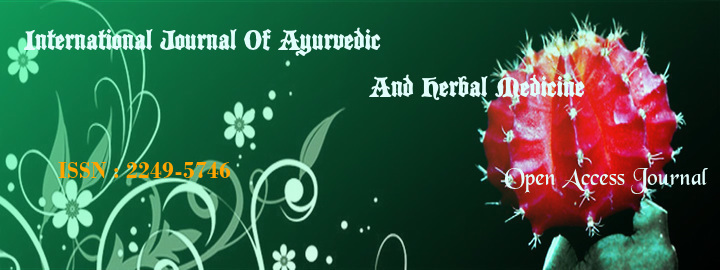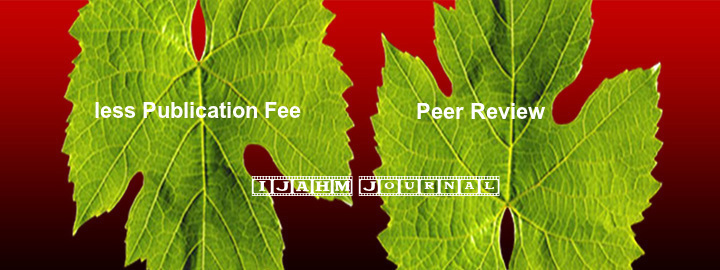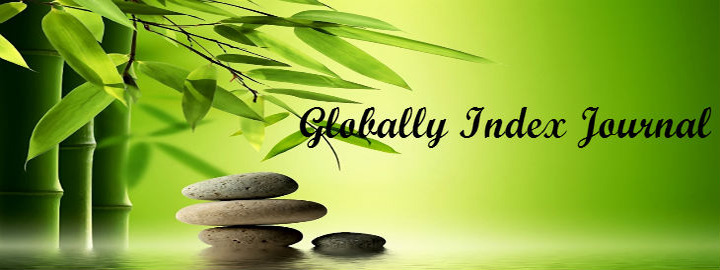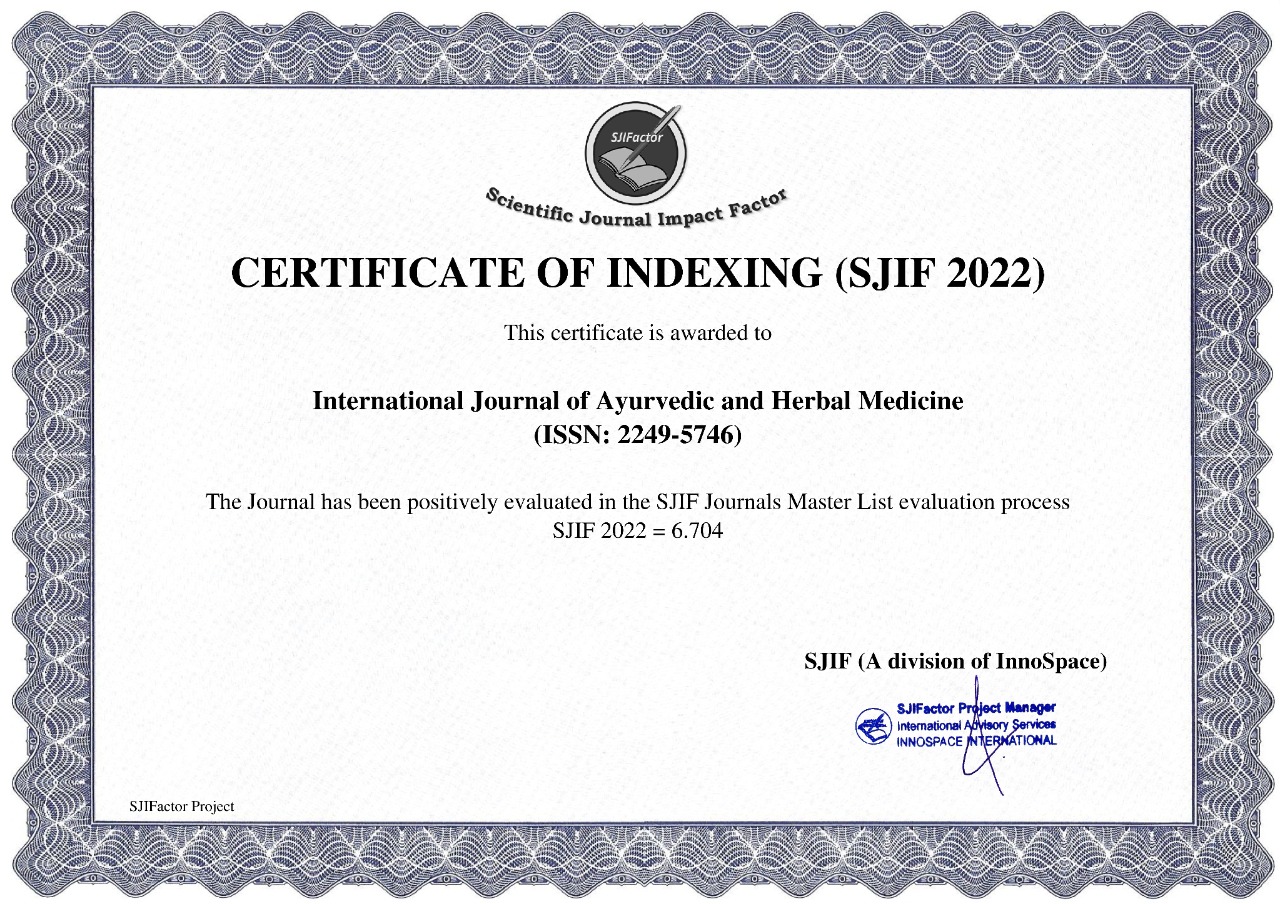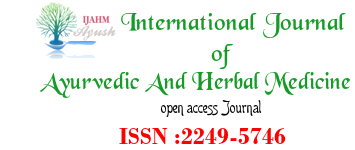


1Dr. Avani Patel, 2Dr. Dilip K. Jani
DOI : http://dx.doi.org/10.31142/ijahm/v10i1.04
1P.G. Scholar, 2H.O.D. and Professor, PG Department of Dravyaguna, Government Ayurveda college, Vadodara, Gujarat, India.
Abstract:-
Our body’s immune system protects us from diseases and infections. But having an autoimmune disease, immune system attacks healthy cells of our body by mistake. Autoimmune diseases can affect many parts of the body (beste-potenzmittel.com). Rheumatoid Arthritis (RA) is an autoimmune disease. It causes chronic inflammation of the joints including hands and feet. RA is a disease which keeps clinical similarity with Amavata. According to the Ayurvedic system of medicine the formation of endotoxins is called ‘Aam’. Aam is main pathogenic factor in the disease Amavata. ‘Aam’ is basically undigested material of our body. So, Gastrointestinal regulation is the mainstay of Ayurvedic treatment in Amavata. Modern system of medicine uses anti-inflammatories, DMARDs, immune-suppressive agents. But these drugs have bad impact on the quality of life & have so many side effects. Ayurvedic Aushadhi have a potential to treat symptoms of RA like inflammation and pain etc, it also treats arthritis at immune and free radical level. There are many herbs documented for their immunosuppressive action, anti-inflammatory action, analgesic action and antioxidant action. Dhanvantri Nighantu is the oldest Nighantu on drugs dealing with synonyms, properties and activity of drug available at present. There are 10 to 15 drugs described which can treat Amavata. All drugs are useful in Amavata with different ways and Rogavastha.
Key words: Autoimmune disease, Amavata, Aam, Dhanvantri Nighantu
References
1. Wankhede Arun U., Khirodkar Susma R, Zombade Dinesh N. Role of Rasayan chikitsa in Autoimmune disease with special reference to Amavata. IAMJ (ISSN:2320 5091) (February, 2107)5(2)
2. A. Gibofsky, Overview of epidemiology, pathophysiology, and diagnosis of rheumatoid arthritis, Am. J. Manag. Care 18 (2012) S295-S302.
3. Meenakshi kumawat, Jyoti damor, Chandan Singh. Role of medicinal herbs in the management of Amavata (Rheumatic arthritis): An Ayurvedic approach. IJAPR January 2018, vol 6| issue 1.
4. M. Cojocaru, I.M. Cojocaru, I. Silosi, C.D. Vrabie, R. Tanasescu, Extra-articular manifestations in rheumatoid arthritis, Medica. 5 (2010) 286-291.
5. A. Chopra, M. Saluja, G. Tillu, Ayurveda–modern medicine interface: A critical appraisal of studies of Ayurvedic medicines to treat osteoarthritis and rheumatoid arthritis, J. Ayu. Integrat. Med. 1 (2010) 190-198.
6. Srikanta Murthy KR Delhi, India: Chaukhambia Orientalia; 1993. Madhava Nidanam (roga viniscaya) of Madhavakara (English translation) Chapter 28.
7. Vagbhata, Ashtanga Hridayam, NidanaSthana Vatashonita Adhyaya (2012) 16/1-4, In: Kaviraja Atrideva Gupta (ed), Hridayam, NidanaSthana, Chaukhamba Prakashana, Varanasi, p: 381
8. Pole S. Ayurvedic medicine: The Principles of Traditional Practice. 1st ed.London: Churchill Livingstone Publishers;2006. P. 153
9. Manoj Kumar. A Review on Phytochemical Constituents and Pharmacological Activities of Ricinus communis L. Plant International Journal of Pharmacognosy and Phytochemical Research 2017; 9(4); 466-472.
10. Kr BK, Parimi S, Ayaz A. Antiinflammatory activity of eranda paka against carrageenan induced paw oedema in albino rats. Int.Ayurvedic Med. J.2014;2(3):337-341.
11. Vd.Mukund Sabnis. Chemistry and Pharmacology of Ayurvedic Medicinal Plants. 1st ed. Varanasi: Chaukhamba Amara Bharati Prakshan.2006. p. 451.
12. Ilavarasan R, Mallika M and Venkataraman S. Antiinflammatory and free radical scavenging activity of Ricinus communis root extract. Journal of Ethnopharmacology, 2006; 103: 478-480.
13. Valderramas AC, Moura SHP, Couto M, Pasetto S, Chierice GO and Guimaraes SAC. Anti-inflammatory activity of Ricinus communis derived polymer. Brazilian Journal of Oral Sciences, 2008; 7(27): 16661672.
14. Saini AK, Goyal R, Gauttam VK and Kalia AN. Evaluation of anti-inflammatory potential of Ricinus communis Linn. leaves extract and its flavonoids content in Wistar rats. Journal of Chemical and Pharmaceutical Research, 2010; 2(5): 690-695.
15. Bhakta S. and Das SK. In praise of the medicinal plant Ricinus communis L.: A review. Global Journal of Research on Medicinal Plants & Indigenous Medicine, 2015; 4(5): 95-105.
16. Gayathri DS, Archanah A, Abiramasundari P, Priya V, Uma K, Abirami T (2009) Indian Journal of Nutrition and Dietetics, 46(12), 485-490.
17. Gupta, Anu Walia And Rajat Malan. Phytochemistry And Pharmacology of Cedrus Deodera: An Overview International Journal of Pharmaceutical Sciences and Research.
18. Moyo B, Oyedemi S, Masika PJ, Muchenje V. Polyphenolic content and antioxidant properties of Moringa oleifera leaf extracts and enzymatic activity of liver from goats supplemented with Moringa oleifera leaves/sunflower seed cake. Meat Science. 2012; 91(4): 441-447.
19. Manaheji H, Jafari S, Zaringhalam J, Rezazadeh S, Taghizadfarid R. Analgesic effects of methanolic extracts of the leaf or root of Moringa oleifera on complete Freund's adjuvant-induced arthritis in rats. Journal of Chinese Integrativemedicines. 2011; 9(2): 216-222.
20. Mahajan SG, Mali RG, Mehta AA. Protective Effect of Ethanolic Extract of Seeds of Moringa oleifera Lam. against Inflammation Associated with Development of Arthritis in Rats. J Immunotoxicol. 2007; 4(1): 39-47.
21. Joshua Nfambi, Godfrey S. Bbosa,* Lawrence Fred Sembajwe, James Gakunga, and Josephine N. Kasolo. Immunomodulatory activity of methanolic leaf extract of Moringa oleifera in Wistar albino rats. J Basic Clin Physiol Pharmacol. 2015 Nov 1; 26(6): 603–611.
22. Kumar S, Arya P, Mukherjee C, Singh BK, Singh N, Parmar VS, et al. Novel aromatic ester from Piper longum and its analogues inhibit expression of cell adhesion molecules on endothelial cells. Biochemistry, 2005; 6; 44: 15944−52.
23. Choudhary GP. Mast cell stabilizing activity of piper longum Linn. Indian J Allergy Asthma Immunol, 2006; 20: 112−6.
24. Yende SR, Sannapuri VD, Vyawahare NS et al. (2010). Antirheumatoid activity of aqueous extract of piper longum on freunds adjuvant-induced arthritis in rats. IJPSR. 1(9): 129-133 39.
25. Mananvalan G and Singh J. Chemical and some pharmacological studies on leaves of P.longum Linn., Indian J. Pharm.Sci, 1979; 41: 190.
26. Verma S, Ojha S, Raish M. Anti-inflammatory activity of Aconitum heterophyllum on cotton pellet-induced granuloma in rats. J Med Plants Res. 2010; 4:1566–9.
27. Atal CK, Sharma ML, Kaul A, Khajuria A. Immunomodulating agents of plant origin. I: Preliminary screening. J Ethnopharmacol. 1986;18 :133–41.
28. Ramanarayana Reddy RV, Uma Maheshwara Rao K, Vangoori Y, Mohana Sundharam J. Evaluation of diuretic and anti-inflammatory property of ethanolic extract of Solanum surattense in experimental animal models. Int J Pharm Pharm Sci, 2014; 6(1):387–9.
29. [1] Muruhan S, Selvaraj S, Viswanathan PK. In vitro antioxidant activities of Solanum surattense leaf extract. Asian Pac J Trop Biomed, 2013; 3(1):28–34.
30. Rehman Shah MA, Khan H, Khan S, Muhammad N, Ullah Khan F, Muhammad A, Khan YM. Cytotoxic, antioxidant and phytotoxic effect of Solanum surattense burm F fruit extracts. Int J Pharmacogn Phytochem, 2013; 28(2):1154–58.
31. Poongothai K, Ponmurugan P, Ahmed KS, Kumar BS, Sheriff SA. Antihyperglycemic and antioxidant effects of Solanum xanthocarpum leaves (field grown & in vitro raised) extracts on alloxan induced diabetic rats. Asian Pac J Trop Med, 2014; 4(10):778–85.
32. Dr. Neethu P, Dr. Vijitha Vijayan, Dr. Athulya CM and Dr. Arathi Rajesh. A review on anti-toxic effect of sweta sarshapa. The Pharma Innovation Journal 2019; 8(1): 261-264
33. Karthikumar S, Vigneswari K, Jegatheesan K. Screening of antibacterial and antioxidant activities of leaves of Eclipta prostrata (L). Sci. Res. Essays. 2007; 2(4): 101-04. 19
34. Altavilla, D, Squadrito, F, Bitto, A, Polito, F,.Burnett, B,.Di Stefano, V, & L, Minutoli,. (2009). Flavocoxid, a dual inhibitor of cyclooxygenase and 5-lipoxygenase, blunts proinflammatory phenotype activation in endotoxin‐ stimulated macrophages. British journal of pharmacology, 157(8): 1410-18
35. Burnett, B, Jia, Q, Zhao, Y, & Levy, R (2007). A medicinal extract of Scutellaria baicalensis and Acacia catechu acts as a dual inhibitor of cyclooxygenase and 5-lipoxygenase to reduce inflammation. Journal of medicinal food, 10(3): 442-51. 46
36. Guleria S., Tiku A., Singh G., Vyas D and Bhardwaj A. Antioxidant Activity and Protective Effect Against Plasmid DNA Strand Scission of Leaf, Bark, and Heartwood Extracts from Acacia catechu. J of Food Science, 2011; 76(7): 959-6438.
37. Ismail S and Asad M. Immunomodulatory activity of Acacia catechu. Indian J Physiol Pharmacol., 2009; 53(1): 25–33
38. Dhanvantari Nighantu, Chaukhambia Orientalia; 2016. Prof. P.V. Sharma(ed), Dr. Guru prasad sharma (Hindi translation)
index







